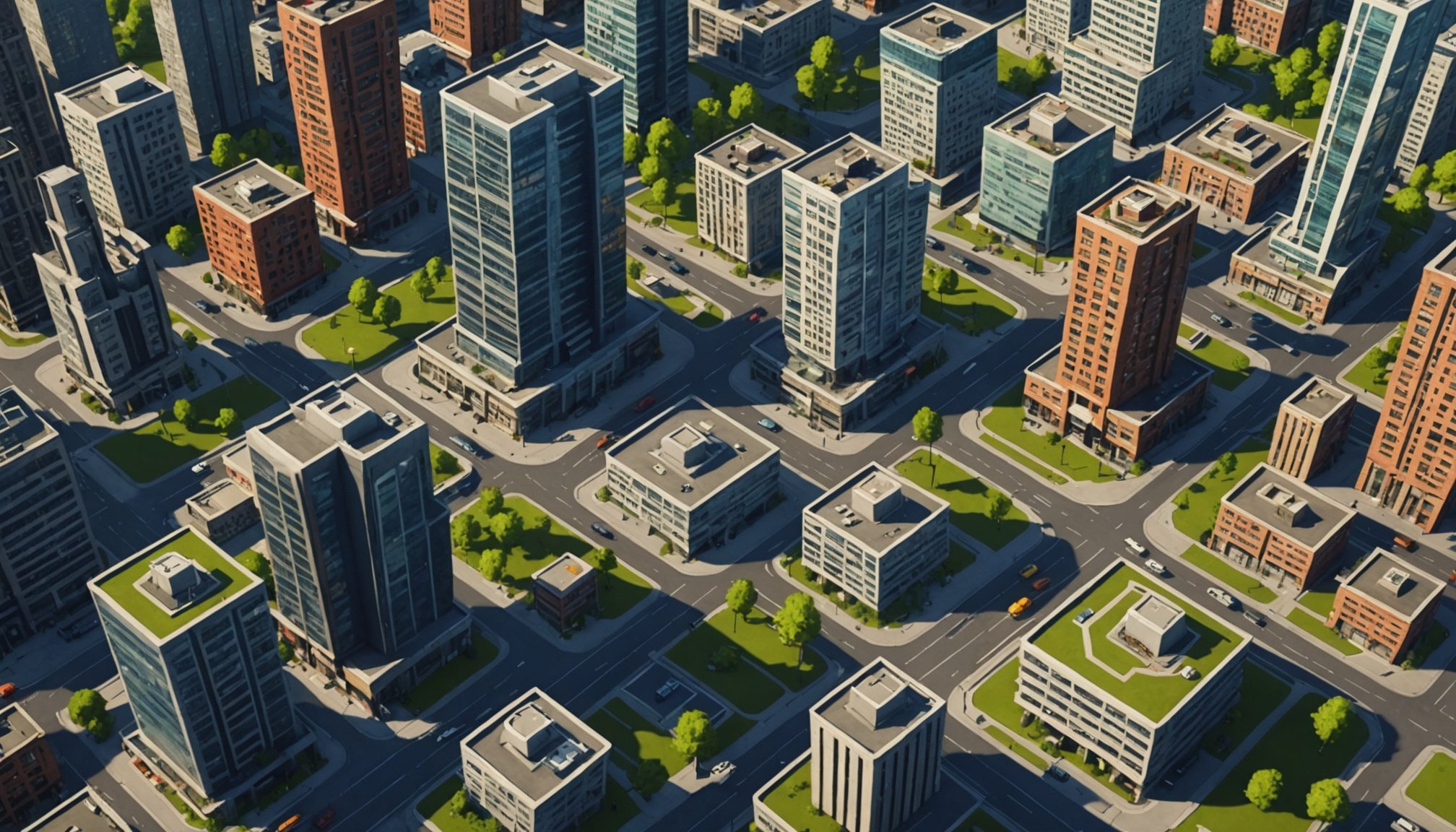Understanding Procedural Generation
Procedural Generation in gaming is a fascinating process that uses algorithms to create content dynamically, rather than relying on manually designed assets. This approach enables developers to produce vast playing environments without excessive resource consumption. Algorithmic Design is at the heart of procedural generation, offering a systematic method to develop diverse game elements repeatedly. This design approach is particularly effective in city-building mechanics, where it can generate urban landscapes that evolve with every playthrough, providing a fresh experience for players.
Historically, procedural generation in city-building games began to gain traction as developers sought to enhance player engagement by creating environments that could not be entirely predicted. The iconic SimCity series pioneered some early procedural methods, illustrating the potential for immersive and replayable urban planning simulations.
Also to see : Unlocking the Roadblocks: Challenges of Voice-Controlled Interfaces in Strategy Games Revealed
Key algorithms like Perlin noise and the Diamond-square algorithm serve as the backbone for generating textures and terrain. In the realm of city-building mechanics, these algorithms help in crafting varied cityscapes that adapt to player actions and decisions. As a result, procedural generation transforms the gaming landscape, enabling users to engage with truly unique and personalised virtual worlds.
Examples of Procedural Generation in City-Building Games
In the world of gaming, procedural city design has revolutionised how developers create immersive environments. By using procedural generation, games can offer players unique and dynamic experiences that evolve with every playthrough. Several notable games have successfully incorporated these techniques to enhance gameplay and user engagement.
Topic to read : Mastering Real-Time Language Translation for Seamless Multiplayer Gaming: Top Strategies for Fluent Communication
Notable Games Utilizing Procedural Generation
One of the most prominent examples is Cities: Skylines, a game that has become synonymous with procedural city design. It uses procedural elements to craft expansive urban areas where each decision impacts the city’s growth and landscape. This unpredictability offers players an innovative way to build and manage their urban environments.
Case Study: Cities: Skylines
Cities: Skylines exemplify how procedural generation can lead to limitless city-building possibilities. It allows for an organic evolution of cities, ensuring each player’s experience is distinct. Its success lies in integrating complex systems with procedurally generated features, fostering immersive environments.
Innovations in No Man’s Sky
While not solely focused on city-building, No Man’s Sky utilises procedural generation to create vast, explorable worlds. Its expansive universe showcases the potential of procedural design in developing unique virtual worlds, illustrating that procedural generation isn’t limited to urban landscapes but can extend to entire ecosystems.
Benefits of Procedural Generation in Gaming
Embracing procedural generation in gaming unlocks a world of possibilities for both developers and players. The primary advantage is its ability to elevate replayability; each playthrough presents a fresh dynamic environment that reshapes itself, ensuring no two experiences are identical. Players are consistently intrigued, as their decisions influence city structures and layouts in unforeseen ways, fostering increased user engagement.
Gameplay benefits abound as procedural generation facilitates more extensive creative freedom. Developers can create expansive game worlds without allocating resources to manually design every detail. This allows for vast city-scape varieties, where players can explore endless possibilities. They can build and grow their environments, making every decision count and enhancing their overall journey.
Moreover, procedural generation can nurture creativity, offering players a plethora of unique experiences. By providing a sandbox of potential scenarios, it encourages strategic thinking and complex problem solving. As players interact with the mechanics, the game adapts seamlessly to their choices.
Ultimately, the adoption of procedural generation drives game design into an era of dynamic and emergent gameplay, accentuating the joy of discovery and the thrill of mastering ever-evolving landscapes.
Drawbacks of Procedural Generation
Procedural generation, for all its benefits, presents notable challenges for developers. At the forefront is content quality, where procedurally generated elements may lack the intricate detail of manually crafted ones. Aiming for consistency can become arduous, resulting in environments that might seem repetitive or generic if not meticulously designed.
Limitations of Procedural Algorithms
Procedural algorithms are powerful yet inherently limited by the rules they follow. They can create vast, visually stimulating environments, but may struggle with nuanced storytelling. The algorithms thrive on randomness yet often require significant refinement to meet gameplay standards.
Impact on Storytelling and Lore
In games where narrative depth is crucial, procedural generation can complicate storytelling and the establishment of lore. The spontaneity that enhances gameplay might conflict with scripted events or dialogue, risking disjointed story threads.
Balancing Variety and Coherence
Developers must cleverly balance variety to maintain engaging player experiences. Ensuring coherence within procedurally generated worlds is paramount for immersion. Strategies include combining algorithmic elements with traditional design, offering both dynamic environments and a cohesive narrative, keeping players engaged without sacrificing quality.
The Future of City-Building Games and Procedural Generation
As we explore the future trends in procedural generation, we recognise the swiftly advancing technological advancements poised to redefine game development. Emerging technologies, such as machine learning and AI, are being harnessed to create more complex and adaptive procedural systems. These technologies promise to deliver dynamic environments that evolve in real-time with unparalleled precision.
Anticipated shifts in player expectations suggest an appetite for more intricate and intertwining gameplay mechanics. Players are looking for environments that respond intuitively to their decision-making processes, providing a truly immersive experience. This places a demand on developers to push the boundaries of algorithmic design, creating not just expansive landscapes but also narratively rich and emotionally engaging urban settings.
In terms of gameplay mechanics, there is potential for a paradigm shift towards more integrated and sustainable environments. Developers might leverage procedural techniques to enhance the complexity of ecosystems within games, offering nuanced city dynamics that mirror real-world challenges. Consequently, city-building paradigms could evolve to incorporate ecological considerations, social dynamics, and moral choices, presenting a fresh landscape for innovation in procedural generation.
Comparing Procedural Generation with Traditional Game Design
Understanding the balance between procedural generation and traditional game design is essential for modern developers seeking to innovate within game architecture. While procedural generation employs algorithms for crafting expansive environments, traditional design relies on manually crafted assets, often ensuring detailed and tailored player experiences.
The Role of Developers in Game Design
Developers play a crucial role in both methodologies, dictating the direction and user engagement of a game. In procedural contexts, developers must fine-tune algorithmic design to maintain creativity while ensuring coherent gameplay. In traditional design, they focus more on storytelling and immersive world-building.
Player-Centric Design vs. Algorithmic Trends
Player-centric design focuses on user feedback, which is a growing trend in game development. While algorithmic-driven games can offer new, dynamic experiences, they may struggle with direct player input. Developers need to balance player excitement with the unpredictability of procedurally generated worlds.
Integrating Traditional and Modern Techniques
A promising approach is hybrid design, which marries city-building mechanics with both procedural and traditional elements. This integration allows developers to combine the spontaneous creativity of procedural models with the narrative depth of traditional designs, yielding enhanced player experiences while maintaining innovation.










